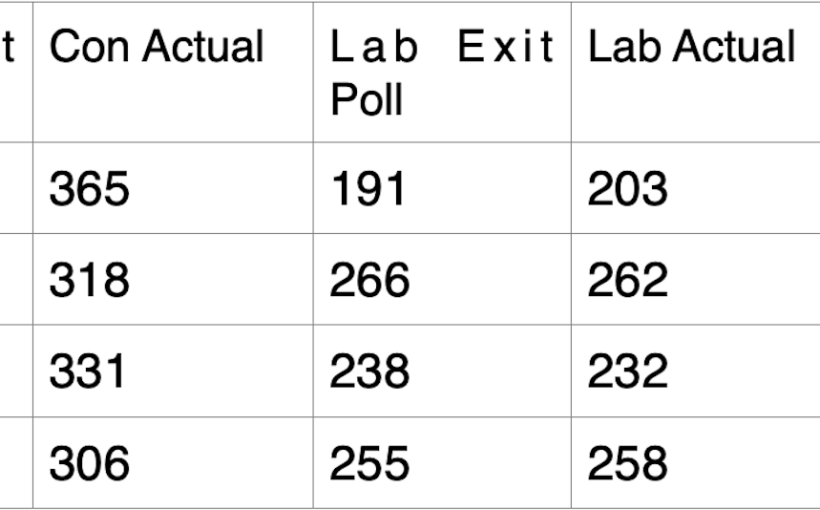The first big moment on election night in the UK, after polls close, happens at 10pm sharp. This is when the exit poll is released and the media commentary floodgates are reopened after a day of media silence, according to broadcasting rules.
Lots of polls are published during an election campaign, but the exit poll is different. While most other polls are snapshots of voting intention at a point in time, the exit poll is essentially what everyone wishes a poll could be – a prediction of the election result.
The exit poll is paid for by a media consortium made up of the BBC, Sky News and ITV. The polling and market research company Ipsos collects the data, which is analysed by the expert exit poll team from a secret bunker in central London.
How does the exit poll work?
Opinion polls during an election tend to tell you one, or both, of two things: the projected vote share for each political party, and the projected number of seats each party will get. They make these projections by interviewing a panel of people over the phone, or inviting them to take a survey online, where they ask who they’re planning to vote for. Pollsters aggregate and weight responses to arrive at their overall expectation for how the country would vote.
While most polling companies do an excellent job, the people answering those surveys might not be predicting their own behaviour very well, and there are a lot of statistical choices that need to be made when analysing their answers. Therefore those opinion polls are an estimation – a best guess based on that day.
The exit poll is a different kind of survey. Instead of asking people what they think they might do, it asks them what they’ve just done.
Ipsos fieldworkers stand outside 100-150 carefully selected polling stations. They count the number of people who leave, and ask a certain number of them to fill out a replica secret ballot. These are counted and the change in votes for each party, compared with the previous election, is analysed throughout the day until polls close.
This method gets around a lot of the problems faced by survey researchers. It’s a secret ballot, so people don’t feel as embarrassed to be honest. They’re repeating an action, instead of imagining something they might do. We know they’ve voted instead of having to estimate their likelihood of turning out. More people agree to participate than in opinion polls, too.
That’s why instead of being a projection, like the opinion polls are, it’s a prediction.
How accurate is the exit poll?
In most years, the exit poll has been remarkably accurate. In 2019, it was out by just three seats for the Conservatives. It slightly overestimated Scottish National Party and Liberal Democrat success, meaning it was 12 seats under the result Labour got. But the overall picture was strikingly similar to the eventual outcome.

In 2017, the exit poll was out by just four seats for both the two main parties, and two seats for the Lib Dems and the national parties.
In 2015 the exit poll correctly predicted the Conservatives as the largest party, which came as a surprise because polls, until that point, had left everyone expecting a hung parliament. That year, the House of Lords ended up launching an inquiry into the polling industry because of this failure to pick up what was about to happen.
Want more election coverage from The Conversation’s academic experts? Over the coming weeks, we’ll bring you informed analysis of developments in the campaign and we’ll fact check the claims being made.
Sign up for our new, weekly election newsletter, delivered every Friday throughout the campaign and beyond.
The exit poll has had some notable misses of its own, though. In 1992, there were separate exit polls for different media companies. Both of them predicted a hung parliament, when in fact John Major’s Tories won a majority of 21 seats.
Generally, though, it gives us a pretty good idea of the story that is about to unfold overnight.
Does this mean I can go to bed at five past ten?
True nerds couldn’t possibly sleep on election night with all the excitement unfolding. But most people will wonder whether they can get some kip because the exit poll tells us the result just in time for our hot cocoa.
But there’s always a chance the exit poll will miss something – and that’s slightly more likely this year, in particular. This is not because of anything that could be avoided, but because the electoral map has been redrawn as a result of boundary changes. There’s therefore more uncertainty around tracking the changes in votes.
Some constituencies no longer exist, some have been merged and some have been created from fragments of multiple other constituencies. So when the exit poll workers attempt to measure changes from the last election onto this election, they are working with a far more complex picture. The scale of the swings expected in 2024 also makes the job trickier.
If you must, a good trick is to watch the exit poll then sleep for a few hours, and wake up again at around 3am to see how it’s going. Then either get hooked and strap in for the rest of the morning, or catch a few more zzzs and come back at 6am.
This is going to be a historic election, though, and you wouldn’t want Fomo, so I’d always recommend staying tuned all night.
![]()
Hannah Bunting is a consultant for Sky News as an elections analyst. She has previously received funding from the Economic and Social Research Council (ESRC).



